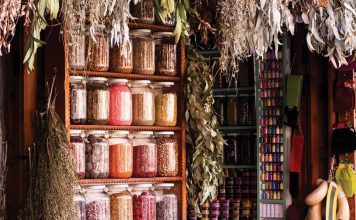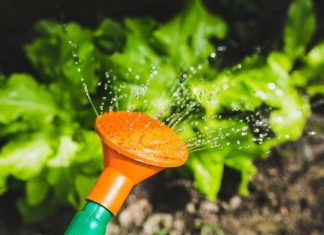 |
|
| Issue #97 • January/February, 2006 |
Call me a sourpuss, if you will, but I love vinegar and can’t imagine a day going by without calling upon one type or another for cooking, curing, or cleansing purposes.
Vinegar gets its name from Latin (vinum for wine and acer for sour) and is one of the oldest condiments in the world. It is believed to have been discovered quite by accidentwine exposed to air and voila, “sour wine” or vinegar came to be known. Too tart to drink, too precious to throw away, creative experimentation proved that soured wine had fascinating propertiesone of them being the power to pickle!
Ancient Egyptians and Chinese used vinegar thousands of years before Christ, and its use is mentioned in both the Old and New Testaments. Traces of vinegar were discovered in an Egyptian vessel dating back 10,000 years. Babylonians used it for cleansing and preserving food, and in Rome legionaries drank vinegar before battle believing it gave them strength and courage. After the fighting was over, vinegar was applied as a disinfectant to cleanse wounds inflicted by swords.
When I was a kid, inexpensive distilled white vinegar was one of the handiest staples in my grandmother’s pantry. Even though she depended upon it for nursing boils, cold sores, skin rashes, bug bites, nosebleeds, and dozens of other everyday nuisances as well as for housecleaning purposes, Grandma vouched that distilled white vinegar was far too strong for the stomach to handle.
Distilled white vinegar is not a healthy choice for table use because harsh chemicals and solvents are used during distillation to make the vinegar clear. Sometimes called “dead” vinegar, due to intense heat involved in the process, the life-giving “mother” is destroyed along with beneficial enzymes, minerals, and other nutrients like malic and tartaric acids, noted for flushing impurities from the body.
Even though it is not recommended for consumption, distilled white vinegar is environmentally friendly and easy on the budget, making it an excellent alternative to chemical cleaning solutions for ridding germs and unpleasant odors around the house.
|
For healthy eating and medicinal tonics, I learned from Grandma to reach for a jug of pure apple cider vinegar to do the trick. If you don’t make your own apple cider vinegar as my grandmother did, make sure you purchase organic vinegarone that has been fermented out of organically grown apples, un-pasteurized to preserve nutritional goodness. Read the label to ensure there are no chemicals, additives, or preservatives in the bottle.
Cider vinegar is recorded in Grandma’s old doctoring journals as being useful tonic for many ailments including cold, flu, sore throat, and stuffy head. It is also good for flushing impurities from the kidneys, bladder, and liver.
Studies have indicated that apple cider vinegar helps relieve arthritic pain, either taken orally or applied on a hot compress. Patting a twisted ankle or sprain with a cloth that’s been soaked in cider vinegar reduces swelling.
Apple cider vinegar is useful treatment for insomnia, constipation, nervousness, muscle cramps, and other afflictionssome of which are much less common today than in Grandmother’s doctoring days. Her scribblers testify that it can be administered to expel intestinal worms and, when used as a hair rinse, rids head lice by dissolving nests.
I still depend on distilled white and apple cider vinegars for cleaning solutions and old remedies passed down to me from Grandmother, but over the years I have become a connoisseur of more exotic types of vinegar for dressing up meals. In my book, any cook can go from being good to gourmet simply by keeping an aromatic bottle or two of specialty vinegars close at hand.
Unlike my rural grandmother, I have access to larger supermarkets that offer vinegars from around the world. One of my favorite picks is balsamic vinegar from Italy.
Traditional balsamic is made from white Trebbiano grapes and aged, up to a hundred years, in a succession of casks made out of different woods, each instilling a particular flavor and aroma to the vinegar, thus its magical taste and pricier tag.
Malt vinegar with its English roots, is fermented out of barley and grain mash and flavored from casks of beech and birch. When purchasing, look for an organic label.
The quality of Champagne and wine vinegars is determined by the type of wines from which they’re made. The best wine vinegars are made the slow, old-fashioned way in oak barrels with plenty of time to mature naturally. Reds and sherry vinegars are aged longer than whites. When purchasing, look for those derived from organic wines.
Some of the most interesting vinegars are those with Oriental roots made from glutinous rice like award-winning, double-fermented and twice distilled, organic Mirina thick, golden sweet vinegar that’s said to be one of the purest in the world and can actually be sipped like sake.
When shopping for vinegar, use the same guidelines as for fine wine. Good organic vinegar should have a sharp, clean taste and pleasant bouquet and upon inhaling, its origin should be revealed. It should never be cloudy, smell like alcohol, or leave an unpleasant aftertaste. Like wine, it must be kept tightly corked in a cool place. Most vinegars today are 5% acetic acid, except Balsamic, which ideally is 6%.
Although vinegar is rooted in history as a preservative and disinfectant, only in more recent times has apple cider vinegar gained recognition as being a remarkable health booster. Studies have indicated that cider is a powerful detoxifying and purifying agent that provides the body with a wide range of minerals including potassium, phosphorus, sodium, magnesium, calcium, chlorine, sulfur, and iron, as well as a number of essential vitamins and beta-carotene.
Cider vinegar prevents high blood pressure by thinning blood and helps maintain healthy blood sugar levels as well as regulating metabolism, which is beneficial in achieving and maintaining weight loss. Because acetic acid in vinegar helps the body break down and digest rich, fatty foods, many cider vinegar-based diets have sprung into being.
|
Whether or not such diets work, they are not recommended. Over-indulgence with any type of acid can cause harm, especially for those suffering from ulcers or other stomach disorders. Too much acid can wear down the stomach lining as well as cause tooth decay.
But the good news is, sensibly adding cider and other specialty vinegars to one’s diet promotes healthier eating habits, which in turn lowers body fat. Substituting perky vinegar like cider or malt in place of butter, cream, cheese, or other heavy sauces on vegetables is one tasty way to cut fat from the diet.
Sprinkling herbal vinegars on salads is another refreshing way to shape up by cutting down on traditional oily dressings, and using fruity infusions instead of sweet sauces and whipped cream on desserts cuts calories drastically.
If you want to get on the sweet side of sour, all you have to do is enter the exciting world of vinegar. Following are some of the great things you can do with vinegarfrom gourmet cooking tips to soothing sunburn and absorbing pet wet.
On the table
Old World wilts. Grandma always packed a wilt in her picnic basket because she claimed that cider vinegar destroyed bacteria in the digestive system. So if by chance anything got tainted in the sun, the wilt would ward off illness. I like wilts because they are refreshingly good. Wilts are versatile and easy to make. Just shred lettuce, cabbage, dandelion leaves, spinach, cucumber, or a mix of greens and put in an earthen or glass bowl. Boil 1 part cider vinegar to 2 parts water and sweeten with honey. Pour over greens and let steep until cold. Drain before serving.
Light, bright salads. You can cut down or eliminate oil by simply tossing greens with a shake of organic store-bought or homemade herbal vinegar. Making your own is as easy as pairing a herb with a vinegar and finding a neat little bottle with a tight fitting cork. See recipes.
Guilt-free desserts. In Italy, it is common practice to dip fresh strawberries into a little bowl of balsamic vinegar before eating. This is truly a must-try treat. Unlike traditional chocolate or caramel dunks, balsamic vinegar actually draws out and enhances flavor rather than masking it. Try sticking other fruits like banana slices, apple wedges, peach, or pear slices on toothpicks and dipping in balsamic for exciting variety.
Thirst quencher. Stir a tablespoon of apple cider or fruit vinegar (see recipes) into iced water for a tantalizing thirst quencher said to regulate body temperature and clear up bad complexion.
Diva dip. Cider, balsamic, or herbal vinegars poured into the dip bowl make a delightfully light substitute for sour cream, mayonnaise, and other fatty dips. You can dunk veggies until your heart’s content.
Balsamic dip for bread. Here’s a super quick and delicious Old World dish from Italy. Combine ½ cup balsamic vinegar, 3 tablespoons extra virgin olive oil, 5 cloves of roasted mashed garlic, and 1 teaspoon of freshly grated black pepper into a jar. Shake well and let draw in the fridge until the flavors meld. Serve with chunks of crusty bread for dipping. This makes a very elegant appetizer, easy picnic, or impromptu supper.
Getting the most out of soup stocks. Adding a squirt of white wine or apple cider vinegarabout 2 tablespoons per pound of bonesto the stock pot helps leach valuable calcium from the bones. There will be no sour taste, and you’ll be on the plus side of calcium.
Potassium-rich tea. If your stamina needs improving, you may need more potassium in your diet. One teaspoon full of cider vinegar per cup of herbal tea can fill the bill. A dash in place of lemon perks up tea.
Salt substitute. Fill a small-holed salt shaker with cider, malt, or herbal vinegar and use in place of salt on raw onions, tomatoes, poached eggs, steamed vegetables, pasta, or anything else that normally draws you to the shaker. When not in use, keep tightly capped in the refrigerator.
Produce wash. Mix three parts distilled white vinegar to 1 part water in a spray bottle. Use to blast away germs from produce. After spraying, rinse well under cold running water. Store leftover spray, tightly capped, in fridge.
Making your own herb vinegar. Gather a few sprigs of fresh garden herbsmore for stronger vinegar. Basil, dill, rosemary, sage, tarragon, thyme, mint, chives, or whatever is handy in your herb patch. Wash, pat dry, and put in a sterilized bottle. Cover with apple cider, malt, or any wine vinegar or blend of vinegars you desire. Let draw for two weeks, then strain and bottle. Peeled garlic cloves, shallots, peppercorns, chilies, juniper berries, or other spices and seasonings can be added.
Fruit vinegar. Use raspberry, cranberries, blueberries, or choice of fruit in place of herbs. Create unique flavors by adding orange peel, lemon zest, pomegranate seeds, nutmeg pod, cinnamon stick, or other sweet things to the bottle. For the very best in fruit-infused vinegar, use white wine or Champagne vinegar.
In the medicine cupboard
Cold prevention medicine. Peel a knuckle of ginger root and put into a pint jar. Add peeled cloves of 1 head of garlic and two small chili peppers. Cover with cider vinegar that’s been brought to a near boil. Cap tightly and store in fridge. Grandmother’s suggested dosage: Take 1 teaspoon in half cup of water when you feel a cold coming on. Saves indefinitely under refrigeration. Makes good stir-fry sauce or enlivening sprinkle for rice dishes.
Cold and flu tonic. Mix 2 teaspoons of cider vinegar into 1 cup of boiling water and sweeten with honey to taste. When cool, sip slowly. Good for relieving cough and breaking up phlegm. For congestion, serve this mixture hot and inhale the steam.
Heartburn. One teaspoon of cider vinegar mixed into a glass of water taken with a spicy meal makes a reliable neutralizerwarding off heartburn.
Nosebleed. Soak sterile cloth in white distilled vinegar diluted with equal parts water and apply to stop bleeding. According to Grandma’s old notes, the acid in the vinegar seals the broken vessel.
Headache. Bring ¼ cup white distilled or ½ cup apple cider vinegar and 1 cup of water to a boil. Add a generous handful of fresh or several spoons full of dried mint leaves and steep until infused. Cover head with a towel, hold over steaming liquid and inhale fumes. Good treatment for tension or sinus headache.
Itchy skin. Run a cool tub full of water and add 2 cups of white distilled vinegar. This is good for soothing heat rash, hives, mosquito bites, and swimmers itch. Cider vinegar works even betterif you have enough of the good stuff to spare.
|
Sunburn. Pat affected skin with a mixture of cider vinegar and water to cool and relieve pain. This helps prevent blistering and peeling.
Foot odor. Put about a pint of distilled white or cider vinegar into a basin of warm water and soak feet. This deodorizes and softens calluses at the same time. Rinsing socks in this solution after washing acts like a built-in odor eater.
Itchy scalp. Add a couple tablespoons distilled white, rice, or cider vinegar to a quart of warm water and use as final rinse after shampooing. Dissolves soap residue that causes dry, flaking scalp. Rosemary adds fragrance and shine to hair.
Around the house
Sparkling glass. Add distilled white vinegar to water when washing windows and glass decorations. Cuts grease and grime and deters buildup. A quarter cup added to rinse water leaves dishes squeaky clean.
Clean and disinfect chopping blocks. To remove meat, onions, garlic, fish, and other odors, rub with baking soda then sprinkle with white distilled vinegar. Let stand until fizzling stops, then rinse with scalding water and air dry.
Coffee pots. Half distilled white vinegar, half water. Run it through pot to remove lime and calcium deposits. Use in tea kettle, too.
Rid smoke, musky, and pet wet odors. To remove smoke or musky odors from clothes or blankets, add 2 cups white distilled vinegar to the final rinse water. Also rids mothball odor. To remove pet wet from carpetssponge with equal parts white distilled vinegar and water.
Wash machine. To remove soap residue and scum from wash machine, let fill with hot water, add a quart of white distilled vinegar and let stand until soap and scum are dissolved. Then run the cycle through.
Ants. Grandma always said that an ant would never tread in the path of vinegar. Detour them with full strength white distilled vinegar.
Drains. Empty ½ cup baking soda into drain. Add 1 cup of white distilled vinegar. Let the carbon dioxide fizzle until its worn out. Rinse with boiling water. Gets rid of greasy odor and buildup.
Microwave oven. Put 1 cup of vinegar in microwave and nuke until boiling. Let set a few minutes. Remove and wipe steamand odorsfrom oven. Soak kitchen scrub brushes in leftover hot vinegar to disinfect and remove odor.
















